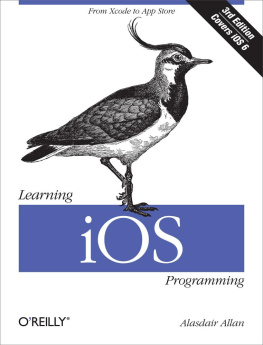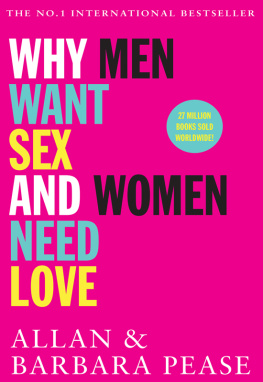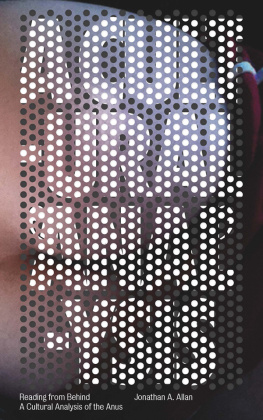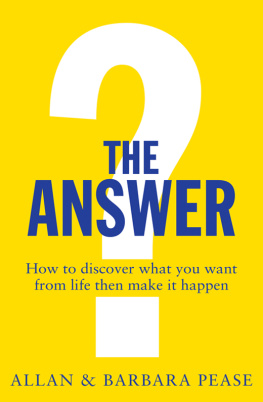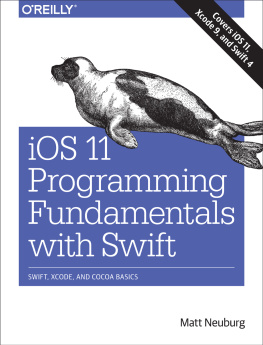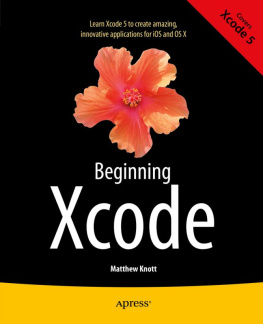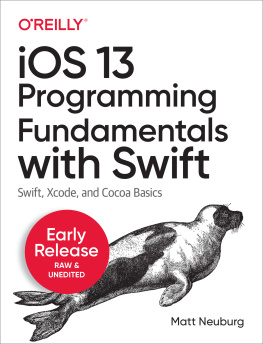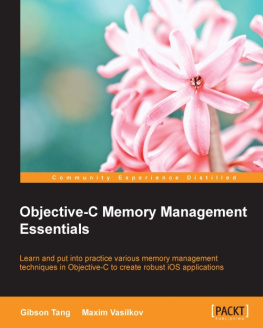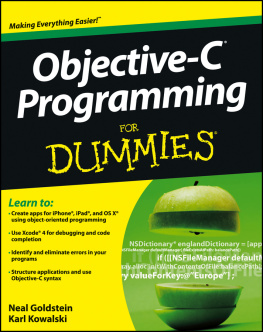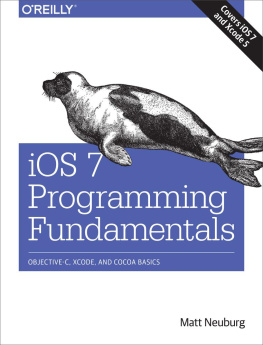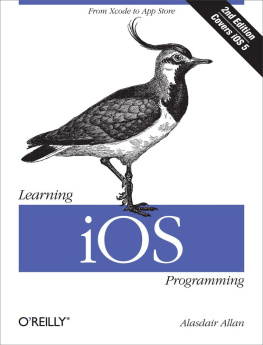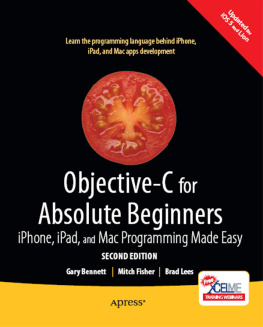Allan - Learning iOS programming: from Xcode to App Store
Here you can read online Allan - Learning iOS programming: from Xcode to App Store full text of the book (entire story) in english for free. Download pdf and epub, get meaning, cover and reviews about this ebook. City: Beijing, year: 2013, publisher: OReilly Media, genre: Computer. Description of the work, (preface) as well as reviews are available. Best literature library LitArk.com created for fans of good reading and offers a wide selection of genres:
Romance novel
Science fiction
Adventure
Detective
Science
History
Home and family
Prose
Art
Politics
Computer
Non-fiction
Religion
Business
Children
Humor
Choose a favorite category and find really read worthwhile books. Enjoy immersion in the world of imagination, feel the emotions of the characters or learn something new for yourself, make an fascinating discovery.
Learning iOS programming: from Xcode to App Store: summary, description and annotation
We offer to read an annotation, description, summary or preface (depends on what the author of the book "Learning iOS programming: from Xcode to App Store" wrote himself). If you haven't found the necessary information about the book — write in the comments, we will try to find it.
Allan: author's other books
Who wrote Learning iOS programming: from Xcode to App Store? Find out the surname, the name of the author of the book and a list of all author's works by series.
Learning iOS programming: from Xcode to App Store — read online for free the complete book (whole text) full work
Below is the text of the book, divided by pages. System saving the place of the last page read, allows you to conveniently read the book "Learning iOS programming: from Xcode to App Store" online for free, without having to search again every time where you left off. Put a bookmark, and you can go to the page where you finished reading at any time.
Font size:
Interval:
Bookmark:

Beijing Cambridge Farnham Kln Sebastopol Tokyo
If you purchased this ebook directly from oreilly.com, you have the following benefits:
DRM-free ebooksuse your ebooks across devices without restrictions or limitations
Multiple formatsuse on your laptop, tablet, or phone
Lifetime access, with free updates
Dropbox syncingyour files, anywhere
If you purchased this ebook from another retailer, you can upgrade your ebook to take advantage of all these benefits for just $4.99. to access your ebook upgrade.
Please note that upgrade offers are not available from sample content.
The arrival of the iPhone changed everything. Or, at the very least, it changed the direction of software development for mobile platforms, which is a pretty big thing. It has spawned an entire generation of copycat devices and brought an entire multibillion-dollar industry to its knees. Despite this, it still fits in your pocket.
There have been a lot fewer changes between the release of iOS 5 and iOS 6 than between the release of iOS 3 and iOS 5, especially since changes to Xcode 4 have now slowed as it has matured. Consequently the changes here in the third edition are less sweeping than they were in the second. Nonetheless, the book you now hold in your hands has been updated to reflect the changes Apple has made to Xcode to support the arrival of the iPhone 5 and iOS 6, as well as discussing the changes in iOS 6 that seemed interesting or relevant to mention as part of a introductory title.
The changes made in the second edition reflected the fact that a lot had happened since the first edition was published: the release of the iPad, a major release of Xcode, two revisions of the operating system itself, and the arrival of Apples iCloud. That book had therefore been refreshed, renewed, and updated to reflect these fairly fundamental changes to the platform, and all of the example code was rewritten from the ground up for Xcode 4 and iOS 5 using ARC.
This book gives a rapid introduction to programming for the iPhone, iPod touch, and iPad for those with some programming experience. If you are developing on the Mac for the first time, drawn to the platform because of the iPhone, or alternatively are an experienced Mac programmer making the transition to the iOS, this book is for you.
The book assumes some knowledge of C, or at least passing knowledge of a C-derived language. Additionally, while I do give a crash course, some familiarity with object-oriented programming concepts would be helpful.
This book will guide you through developing your first application for the iOS from opening Xcode for the first time to submitting your application to the App Store. Youll learn about Objective-C and the core frameworks needed to develop for the iOS by writing applications that use them, giving you a basic framework for building your own applications independently.
Heres a short summary of the chapters in this book and what youll find inside:
UITableView and associated classes are perhaps the most commonly used classes when building user interfaces for iOS applications. Due to the nature of the applications, these classes can be used to solve a large cross section of problems, and as a result, they appear almost everywhere. In this chapter, we dive fairly deeply into the table view classes.After discussing the table view controller in detail, we discuss some of the other view controllers and classes that will become useful when building your applications: simple two-screen views, single-screen tabbed views, modal view controllers, and a view controller for selecting video and images.This chapter discusses connecting to the Internet, browsing the Web, sending email, and retrieving information.This chapter discusses how to handle data input, both from the application user and programmatically, and how to parse XML and JSON documents. The chapter also covers storing data in flat files and storing data with the SQLite database engine.This chapter discusses how to determine what hardware is available and illustrates how to deal with the major sensors on iOS devices: the accelerometer, magnetometer, camera, and GPS.This chapter walks you through the process of building applications that make use of the Core Location and MapKit frameworks.This chapter provides a brief introduction to integrating Apples iCloud service into your own applications. iCloud is a service that helps you synchronize your data across devices, making documents and data available to all of your subscribed devices.This chapter shows you some of the tricks to integrate your application with iOSs software ecosystem, how to present user preferences with Settings Bundles, and how to use custom URL schemes to launch your application. It also discusses how to make use of the Media Player and Address Book.This chapter talks about how to add some final polish to your application and walks you through the process of building your application for distribution, either via ad hoc distribution or for the App Store.This chapter provides a collection of pointers to more advanced material on the topics we covered in the book, as well as material covering some of those topics that we didnt manage to talk about in the book.The following typographical conventions are used in this book:
Constant width Used for program listings, as well as within paragraphs to refer to program elements such as variable or function names, databases, data types, environment variables, statements, and keywords Constant width bold Shows commands or other text that should be typed literally by the user Constant width italic Shows text that should be replaced with user-supplied values or by values determined by contextThis icon signifies a tip, suggestion, or general note.
This icon signifies a warning or caution.
This book is here to help you get your job done. In general, if this book includes code examples, you may use the code in your programs and documentation. You do not need to contact us for permission unless youre reproducing a significant portion of the code. For example, writing a program that uses several chunks of code from this book does not require permission. Selling or distributing a CD-ROM of examples from OReilly books does require permission. Answering a question by citing this book and quoting example code does not require permission. Incorporating a significant amount of example code from this book into your products documentation does require permission.
Font size:
Interval:
Bookmark:
Similar books «Learning iOS programming: from Xcode to App Store»
Look at similar books to Learning iOS programming: from Xcode to App Store. We have selected literature similar in name and meaning in the hope of providing readers with more options to find new, interesting, not yet read works.
Discussion, reviews of the book Learning iOS programming: from Xcode to App Store and just readers' own opinions. Leave your comments, write what you think about the work, its meaning or the main characters. Specify what exactly you liked and what you didn't like, and why you think so.

